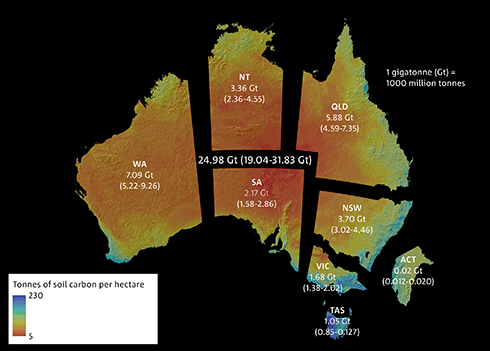
|
Published: 24 March 2014
First accurate map of soil carbon profile across Australia
A new map of Australia's stored soil carbon provides an important benchmark against which Australia can track future changes in soil carbon storage or carbon sequestration.

|
|
The 2010 baseline map of Australia’s soil organic carbon stocks showing the national and state and territory estimates and their uncertainty range. Credit:
CSIRO
|
The 2010 soil organic carbon map for Australia – developed by CSIRO – provides the most detailed and accurate representation of soil organic carbon stocks, to a depth of 30 cm, at a national scale. The series of maps, just published in Global Change Biology, draws on soil sampling data and innovative prediction methods.
It includes an estimate of soil carbon stock and an estimate of the uncertainty (a measure of accuracy) for approximately two billion football-field-sized blocks (90 x 90 m) across Australia.
‘This map is the first effective nationwide baseline of organic carbon levels in the top 30 cm of soil, which comes with estimates of uncertainty,’ according to lead researcher, Dr Raphael Viscarra Rossel.
Until now, estimates of soil organic carbon across the breadth of Australia have not been available or were largely uncertain because of large gaps in data and the limits of past measurement and spatial modelling.
‘The map provides a reliable benchmark for Australia to monitor the influence that changes in land cover, climate, land management and greenhouse gas offset activities have on soil carbon stocks and associated carbon dioxide removal from the atmosphere,’ Dr Viscarra Rossel said.
CSIRO drew on three major datasets, including CSIRO's National Soil and Spectral databases and the national Soil Carbon Research Program – a national research program led by CSIRO and also involving universities and state government agencies. The program is funded by the Australian Government and the Grains Research and Development Corporation.
The map and its prediction methods provide new insight into the environmental drivers that determine the distribution of soil carbon across the nation, its diverse bioregions and its states and territories.
‘Australia's largest soil organic carbon stores per hectare occur in the cool, temperate zones, which have higher-than-average rainfall and extensive rainforests and eucalyptus forests,’ Dr Viscarra Rossel said.
‘These larger stocks of organic soil carbon tend to coincide with southern states and regions fringing the coastlines, where wetter and cooler conditions produce more vegetation growth with slower decomposition and loss of carbon dioxide.
‘South Australia, due to its large amount of desert, is an exception; its soils contain the least amount of organic carbon per hectare, followed by northern and western jurisdictions and regions exposed to Mediterranean, subtropical and tropical climates.’
The maps show the average amount of organic carbon in the top 30 cm of Australian soil was estimated to be 29.7 tonnes per hectare and the total stock for the continent at 25.0 gigatonnes (Gt = 1000 million tonnes) with a 95 per cent confidence of being within the range of 19.0 to 31.8 Gt.
The total stock in agricultural regions of Australia is 12.7 Gt with 95 per cent confidence of being within the range of 9.9 to 15.9 Gt.
According to Dr Viscarra Rossel, the 2010 maps could be used to:
-
set a baseline from which Australia's national soil carbon stocks could be monitored guide the design of national soil monitoring networks
-
help guide future soil sampling designed to improve estimates of Australia's soil carbon stocks
-
help to assess the potential of Australian soil to sequester carbon
-
improve Australia's terrestrial carbon budgeting
-
assist with strategies to mitigate and adapt to the effects of a changing climate.
Source: CSIRO



